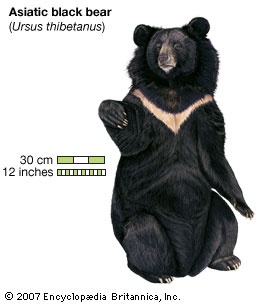Asiatic black bear
mammal
also called Himalayan bear, Tibetan bear, or moon bear
 member of the bear family (Ursidae) found in the Himalayas, Southeast Asia, and part of eastern Asia, including Japan. The Asiatic black bear is omnivorous, eating insects, fruit, nuts, beehives, small mammals, and birds, as well as carrion. It will occasionally attack domestic animals. It has a glossy black (sometimes brownish) coat, with a whitish mark shaped like a crescent moon on the chest. Its long, coarse neck and shoulder hair forms a modified mane. The Ainu people of Japan worship the bear as a god of the mountains and as an ancestor of some mountain-dwelling Ainu. The bear's gall bladder and bile are highly valued for use in traditional Asian medicines, especially in Japan, South Korea, and Singapore. In China, bile is “farmed” by extracting it from captive bears, but elsewhere in Asia wild bears are hunted for their gall bladders and other body parts.
member of the bear family (Ursidae) found in the Himalayas, Southeast Asia, and part of eastern Asia, including Japan. The Asiatic black bear is omnivorous, eating insects, fruit, nuts, beehives, small mammals, and birds, as well as carrion. It will occasionally attack domestic animals. It has a glossy black (sometimes brownish) coat, with a whitish mark shaped like a crescent moon on the chest. Its long, coarse neck and shoulder hair forms a modified mane. The Ainu people of Japan worship the bear as a god of the mountains and as an ancestor of some mountain-dwelling Ainu. The bear's gall bladder and bile are highly valued for use in traditional Asian medicines, especially in Japan, South Korea, and Singapore. In China, bile is “farmed” by extracting it from captive bears, but elsewhere in Asia wild bears are hunted for their gall bladders and other body parts.During the summer the Asiatic black bear lives mainly in forested hills and mountains at elevations up to 3,600 metres (11,800 feet). Becoming fat by fall, it spends the winter at elevations of 1,500 metres (5,000 feet) or less and may sleep for much of the time. An adult male weighs 100–200 kg (220–440 pounds), a female about half as much; its length averages about 130–190 cm (51–75 inches), in addition to a 7–10-cm (3–4-inch) tail. After weaning, the young remain with the mother for as long as three years.
- Ahmad Ghavam el-Saltaneh
- Ahmadinejad, Mahmoud
- Ahmad Khan, Sir Sayyid
- Ahmadnagar
- Ahmadou Ahidjo
- Ahmadou Kourouma
- Ahmadu Seku
- Ahmed Ali
- Ahmed Ben Bella
- Ahmed Cevdet Paşa
- Ahmed Dede Müneccimbaşı
- Ahmed, Fakhruddin Ali
- Ahmed Haşim
- Ahmed H. Zewail
- Ahmed I
- Ahmed, Iajuddin
- Ahmed II
- Ahmed III
- Ahmedi, Taceddin
- Ahmed Messali Hadj
- Ahmed Nedim
- Ahmed Sefrioui
- Ahmed Tevfik Paşa
- Ahmed Vefik Paşa
- Ahmed Yesevi